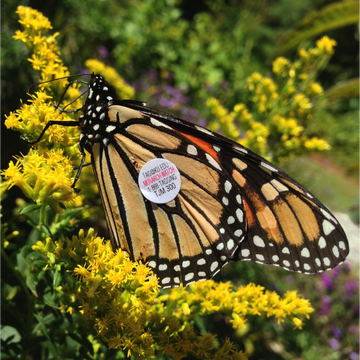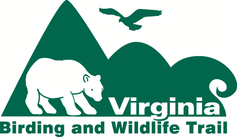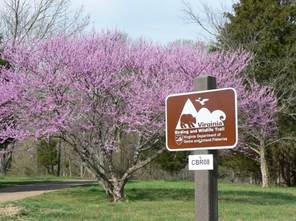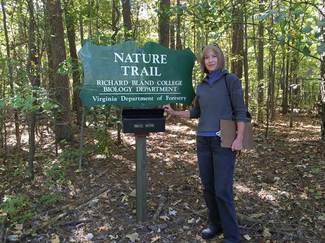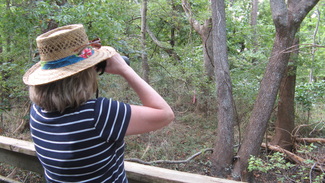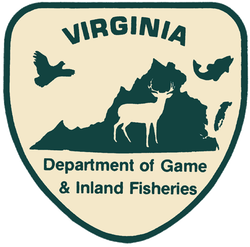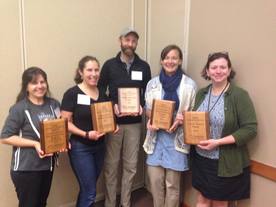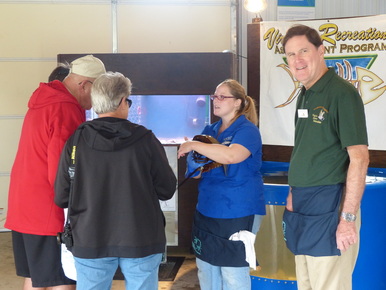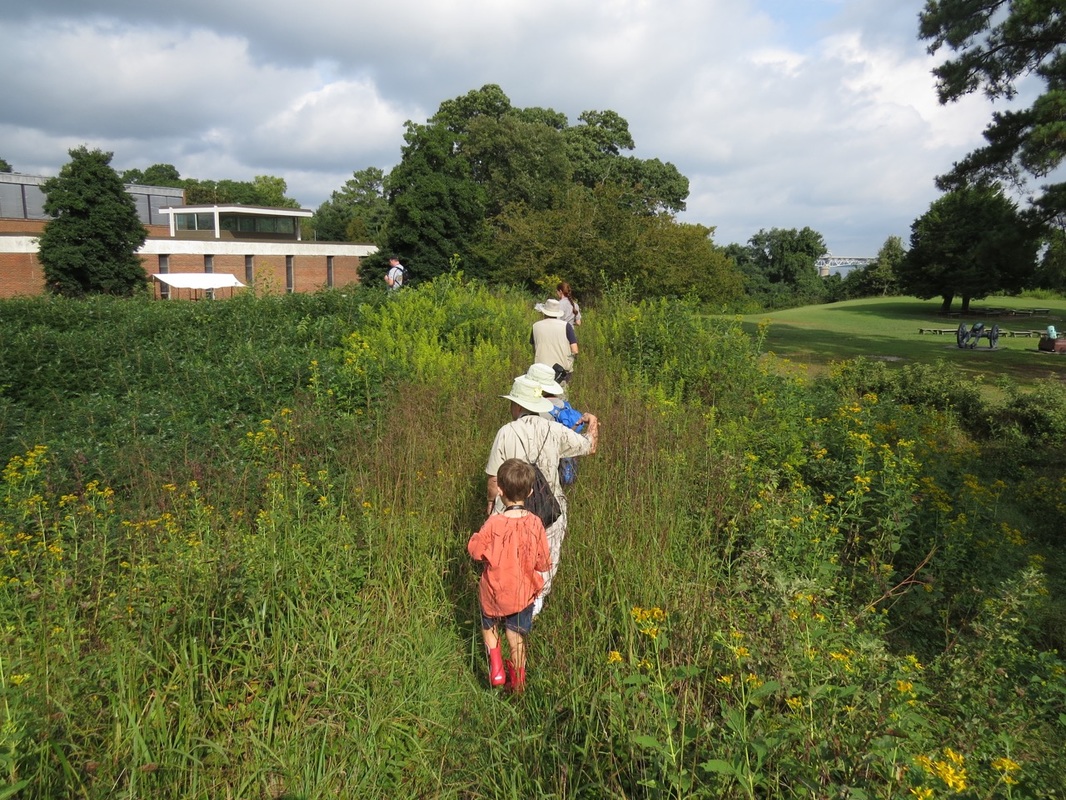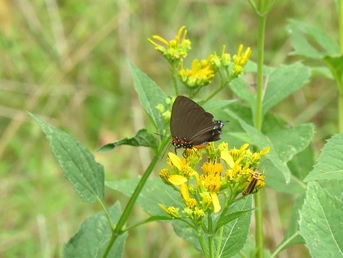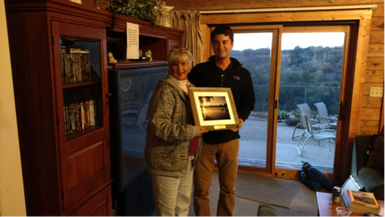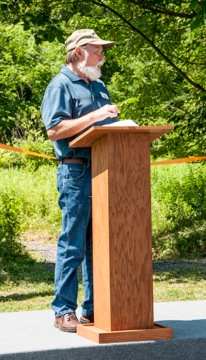Giving Monarchs a Boost in Virginia
Positive steps to conserve monarch breeding habitat and increase monarch populations are underway. In May, a federal inter-agency task force released its strategy to promote pollinator health; increasing monarch butterfly populations is one of its three major goals. The USFWS has launched a campaign to support planting of new monarch habitat across their breeding range. Virginia Master Naturalists have been doing their part as well, using their volunteer time to educate youth and adults about monarchs, to contribute data on monarchs to several large-scale citizen science studies, and to plan and plant milkweed habitat for monarchs and other pollinators in their communities. Here we highlight just a few of the many monarch projects underway in our VMN chapters.
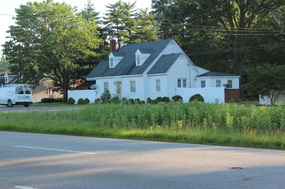 One of several milkweed patches a VMN helped to protect. Photo by Susan Walton.
One of several milkweed patches a VMN helped to protect. Photo by Susan Walton.
-Submitted by Susan Walton, VMN-Peninsula Chapter
Virginia Master Naturalists and other partners are working with the Virginia Department of Transportation to identify suitable roadside areas that could support pollinator habitat. In one example, Susan Walton (VMN volunteer – Peninsula Chapter) partnered with Gloucester VDOT Superintendent Kevin Sears to protect three patches of milkweed along Route 17. Thanks to advice and education provided by Susan, Mr. Sears changed the mowing pattern so that the milkweed patches were not mowed in the summer. While one patch was accidently mowed, in the other two areas the milkweed bloomed and provided nectar and homes for pollinators throughout the summer. The mowed patch grew back to provide young milkweed for the fall monarch migration. VDOT has a Pollinator Habitat Program that they are working to implement statewide, starting with a new planting of more than 8,000 pollinator-friendly plants at the Dale City Rest Area on I-95. Leaders for the project are interested in receiving suggestions for locations where roadside pollinator plants could be located and in recruiting volunteers to help with future efforts.
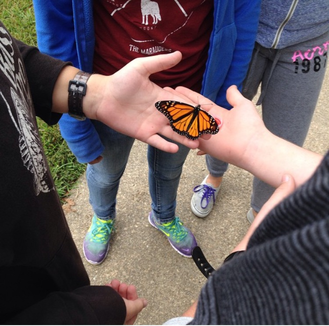 Monarch release at York High School. Photo by Amber LeMonte.
Monarch release at York High School. Photo by Amber LeMonte.
-Submitted by Barb Dunbar, VMN-Historic Rivers Chapter
In 2013 the Historic Rivers and Peninsula Master Naturalists partnered with Virginia Cooperative Extension (VCE) to help teachers and students plan, build, and plant a monarch waystation at ten elementary schools and one high school. Since that time they have had additional schools request their help in creating outdoor classrooms/pollinator habitats for a total of twenty-three schools. Last year, those schools tagged approximately 650 monarch butterflies that were gathered from the school gardens. Many were raised in the classroom enabling students the awesome experience of watching the monarchs go through their transformation from egg to adult butterfly. Some of the schools took on the additional task of testing the monarchs for a protozoan parasite in partnership with the University of Georgia. The project is on track this year to tag another 600+ as they journey to Mexico. Many of the schools have enlarged their gardens focusing on habitat for birds and frogs. The Virginia Master Naturalist and VCE Master Gardener volunteers continue to work with the teachers and students providing expertise in planning additions to the garden and more importantly, helping with hands-on lessons for the students.
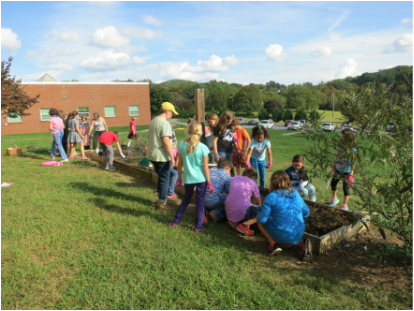 Boone’s Mill Elementary School students plant pollinator habitats on their school grounds with help from Virginia Master Naturalist volunteers.
Boone’s Mill Elementary School students plant pollinator habitats on their school grounds with help from Virginia Master Naturalist volunteers.
Across the state in Franklin County, VMN volunteers Meg and Rich Brager (Blue Ridge Foothills and Lakes Chapter) assist teachers with an afterschool Junior Master Naturalist (JMN) Program for fourth and fifth graders. This year the program focused on monarch butterflies. Each meeting with the children teaches a different aspect of the mon
arch life cycle. In one session with the students this fall, volunteers guided them through weeding two existing at the school, preparing the soil for new plantings, and planting pollinator plants and seeds in the beds. Planting locations were carefully documented so that students can make periodic observations on how each plant is doing.
“We began this project in order to do our small part to help this situation and more importantly to imbue knowledge and love of nature to our younger generation,” wrote Rich Brager. “To say the least, the students were exited to work in the dirt wearing gardening gloves and using various garden implements. To date, our monarch butterfly project has been successful and rewarding. We will look forward to continue this project through the fall, winter and spring.”
The new raised bed was financed by and built by the Skelton 4-H Center supervised by Amber Wilson. The Smith Mountain Lake Association also provided funding for the project.
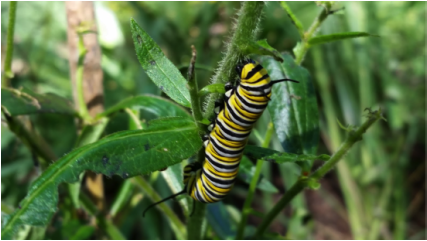 Fifth instar monarch larvae on Asclepias tuberosa, Butterfly Garden 1, Pocahontas State Park, Chesterfield, VA. Photo by VMN Pocahontas Chapter.
Fifth instar monarch larvae on Asclepias tuberosa, Butterfly Garden 1, Pocahontas State Park, Chesterfield, VA. Photo by VMN Pocahontas Chapter.
-Submitted by Jennifer Ambs, VMN-Pocahontas Chapter
Monitoring monarch populations is an important part of their conservation, as we need to understand how the populations are changing and if efforts to provide more habitat are making a difference. There are numerous large-scale citizen science projects focused on monarchs, such as Journey North, Monarch Watch, and the Monarch Larva Monitoring Project, and VMN volunteers are engaged in many of these projects. The VMN Pocahontas Chapter sent a copy of a letter recently sent to Governor Terry McAuliffe, who had visited Pocahontas State Park on Earth Day 2015 to help put in a monarch butterfly habitat.
“Dear Governor McAuliffe,
We are writing to update you on the Monarch Butterfly Garden you initiated in Pocahontas State Park on Earth Day, April 22, 2015. As Virginia Master Naturalists active in the park, we have been monitoring the garden weekly for monarch activity and entering data into the national Monarch Larva Monitoring Project database. The Monarch Larva Monitoring Project (MLMP) is a citizen science project involving volunteers in monarch research. It was developed by the University of Minnesota to collect long-term data on milkweed habitat and larval monarch populations, with the goal of understanding spatial and temporal variation in monarch populations. It aids monarch conservation and increases the understanding of butterfly ecology. As part of this research, we measured milkweed plants and noted the size and general condition of each plant, the presence of predatory insects, and the development of buds, flowers and seed pods. Our garden is one of only nine sites in Virginia participating in the national database for 2015.
We have also registered the garden with Monarch Watch, a project of the University of Kansas that is focused on preserving monarch habitats by creating waystations throughout the migration pathways. The garden at Pocahontas State Park has now been successfully certified as a Monarch Waystation. As participants in Monarch Watch, we tag adult monarch butterflies in order to track the success rate of their iconic migration.
The monarch butterflies found our first-year garden and laid eggs on the milkweed plants. We observed 6 eggs and the following week in early September, found five monarch caterpillars eating the milkweed plants. By the time of our next visit the caterpillars were gone – but we are confident they found their way to nearby branches and successfully completed their cycle to adulthood.
We are grateful for your initiative to establish a garden to help protect and preserve the monarch butterflies, a critical link in the pollination chain of Virginia’s agricultural and natural resources. We are currently preparing for a second garden in another area of Pocahontas State Park. At the same time we will continue to monitor the garden that you helped establish.
We appreciate your support and are proud to be part of this important conservation effort in Virginia.
Sincerely,
Jennifer Ambs, Project Coordinator
Eric Gray, Mary Camp, Karen Daniel, Wanda Cutchins, Katherine Snavely and Joshquinn Andrews, on behalf of the Pocahontas Chapter of the Virginia Master Naturalists
Giving Monarchs a Boost in Virginia Read Post »

